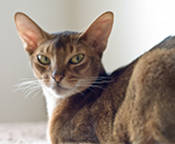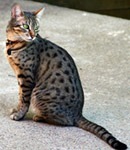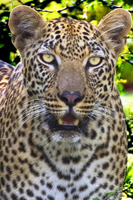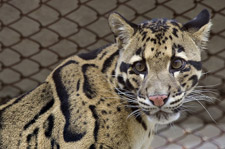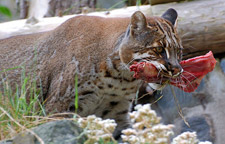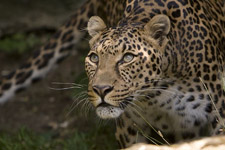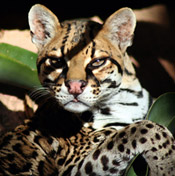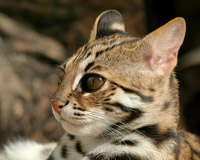Archive for the 'Basics' Category...
Filed under Basics
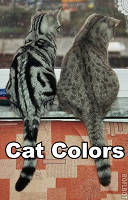 Cats come in a wide variety of colors, dilutions and patterns. That rainbow is part of our inspiration so we thought we look a little closer at the different patterns & colors.
Cats come in a wide variety of colors, dilutions and patterns. That rainbow is part of our inspiration so we thought we look a little closer at the different patterns & colors.
The Basics First
Starting at the beginning, there are a number of solid colors, their coats are made up of only one hair color. This is just the tip of the iceberg, as we started researching we realized just how deep the proverbial rabbit hole goes.
In the coming weeks we’ll go through the many patterns & dilutions that affect these colors in detail.
From blue to red to chocolate, solid colors are more interesting than you may think.
(more…)
Published by Felinest on Wednesday, July 28th, 2010
Filed under Basics
The origins of this breed are a mystery, however physically they resemble cats found in ancient Egyptian hieroglyphs. It is believed that the modern Abyssinian is a descendant of those cats.
Africa Natives
The two main breeds of cat native to that part of Africa are the Jungle Cat and the African Wildcat. In appearance the Abyssinian has many physical traits associated with the Wildcat.
An Interesting Twist
Over the centuries feline blood from many different walks of life contributed to this breeds development. In fact, today’s Abyssinian breed was largely influenced by English breeders who brought the breed to the UK in the mid 19th century.
(more…)
Published by Felinest on Wednesday, July 14th, 2010
Filed under Basics
There is a long list of domestic cat breeds that exist today, but in ancient times things were a little different. In ancient Egypt cats were known as the mau and played an important part in society.
Mau = Cat
The two breeds of cat that are native to Egypt are the Jungle Cat and the African Wildcat. The wildcat proved to be friendlier with people and contributed more to domestication. However both cats were interbred & eventually fused to create a new breed, the animal we call the Egyptian Mau.
Not actually a breed, the Mau was what Egyptians called all cats, regardless of what type of feline they were.
(more…)
Published by Felinest on Tuesday, April 20th, 2010
Filed under Basics
The panthera genus is comprised of the four largest members of the cat family, lions, tigers, jaguars & leopards.
The largest of the big cats, these four species also have an ability the rest of the felidae family doesn’t…they can roar.
Not just tough guys, the big cats have also been reported to purr, although from what we read it has not been clinically proven.
Among the largest land predators in the world almost every member of this genus is victim to very low numbers. We introduce to you genus panthera.
(more…)
Published by Felinest on Wednesday, March 10th, 2010
Filed under Basics
Another small genus, neofelis only encompasses two members of the cat family & they are the smallest of the big cats. These animals inhabit the tropical rain forests of southeast Asia.
This genus is distinct from the other cats, they are similar in size to the small cats, but their skull structure is closer to that of the pantherine cat.
The most notable difference being the size of their canines, which are the largest in relation to body size of all cat species.
(more…)
Published by Felinest on Wednesday, February 24th, 2010
Filed under Basics
This genus has a very distinctly different look than much of the rest of the family & there are only two members.
Genetic research has shown that this genus and the Pardofelis genus should be merged into one, but for the sake of keeping it simple, we’ve introduced them separately. We haven’t seen anywhere that the two have actually been merged into one genus as of yet.
Both subspecies are very rare and found throughout southeast Asia. For many years the Bay Cat cleverly eluded the paparazzi in the wild.
(more…)
Published by Felinest on Wednesday, February 10th, 2010
Filed under Basics
Another introduction to the cat family, it’s time to meet the leopards who interestingly enough are not part of the leopardus genus, but of the panthera genus.
These big cats used to be found from the British Isles all the way to Japan, however today they are almost exclusively in Africa and small parts of Asia & Sri Lanka.
Perhaps the flashiest of the cat breeds, the leopard is definitely known for their stylishly spotted coat.
The leopard can survive in a wide variety of habitats from mountains to swamps.
(more…)
Published by Felinest on Wednesday, January 27th, 2010
Filed under Basics
This is a genus that encompasses a group of small spotted cats that are generally found in Central & South America throughout a wide variety of habitats and ecosystems.
Although most of them are the same size as your neighborhood house cat they aren’t nearly as friendly.
These animals are the oldest branch of the cat family to cross into the Americas. Interestingly enough the leopard is not in this genus, they are in the Panthera genus.
(more…)
Published by Felinest on Wednesday, January 13th, 2010
Filed under Basics
There are four members of the lynx genus, although there has been disagreements about how to classify them & some put them in the felis genus. For the purpose of our introductions, we’ve separated them to keep confusion to a minimum.
These are medium sized cats who have characteristic short tails, tufts of black hair on their ears & big padded paws.
The animals in this genus are found in a wide variety of habitats, & their differing physical characteristics reflect their natural surroundings.
(more…)
Published by Felinest on Wednesday, December 30th, 2009
Filed under Basics
The Prionailurus genus encompasses a number of small Asian cats. They are about the same size as the domestic cat, but differentiated by a thick, short tail, a short snout & large eyes.
While they look similar to their felis cousins their large eyes give them a distinct look.
Collectively this group of cats are typically forest dwellers and known for their swimming ability. Some of the members are semi-aquatic and live mainly on a fish diet.
(more…)
Published by Felinest on Wednesday, December 16th, 2009
 Cats come in a wide variety of colors, dilutions and patterns. That rainbow is part of our inspiration so we thought we look a little closer at the different patterns & colors.
Cats come in a wide variety of colors, dilutions and patterns. That rainbow is part of our inspiration so we thought we look a little closer at the different patterns & colors. 